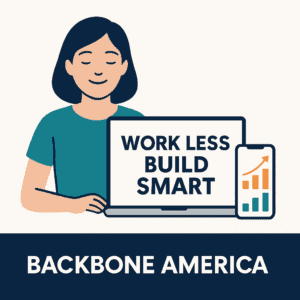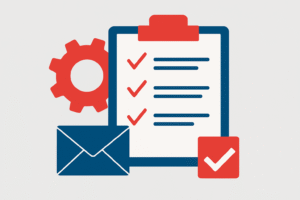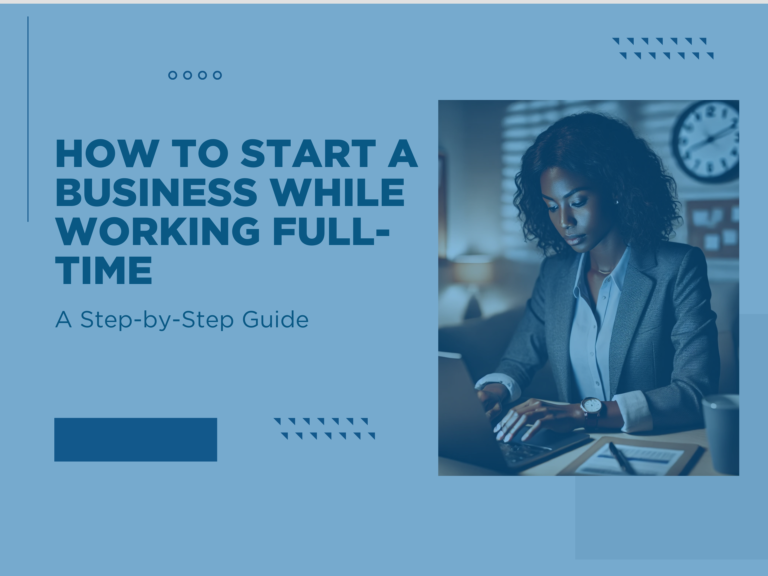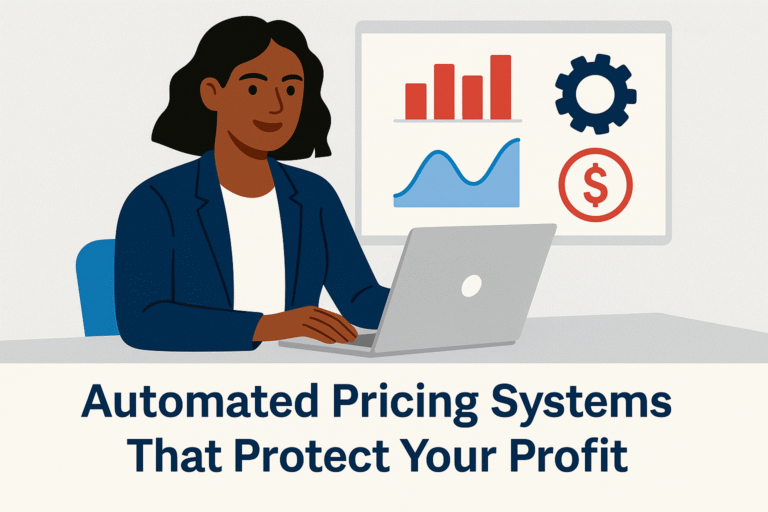Workflow Wednesday
It’s hard to build something meaningful when your time is already maxed out. If you’re working full-time and trying to launch a business on the side, you probably don’t have hours to waste repeating tasks that could’ve been streamlined. You don’t need more willpower. You need better systems. Systems that optimize business processes.
When I revived Backbone America, I made myself a promise: I wouldn’t build it the way I had before. The first time around, I tried to do too many things manually—writing, marketing, fulfillment, follow-up—all on top of being a mom, a wife, and an employee. It wore me down. And honestly, it didn’t work.
But the second time, I had a new toolkit: automation, process design, and a clear focus on sustainability. I learned how to optimize business processes so I wasn’t buried in to-do lists. And that upped my game.
If you’re serious about creating a business that works for your life—not against it—this post is for you. We’ll unpack what it really means to optimize your business processes, so you can build smart from the start… and skip the burnout entirely.
The Hidden Costs of Not Optimizing
It’s easy to tell yourself you’ll figure it out later.
That you’ll create better systems once you’ve got paying clients… or more time… or once the chaos calms down. But the truth? Waiting to optimize is expensive—just not always in ways you can see on a spreadsheet.

When I first tried to build Backbone America, I didn’t think I needed automation. I wasn’t generating revenue yet, so it felt premature to focus on systems. I thought grit and long nights would be enough to carry me through. But all that hustle just left me exhausted—and still behind.
Without clear processes, every task takes longer. Every decision feels heavier. I spent hours reinventing the wheel: rewriting emails, re-uploading files, manually tracking progress with sticky notes and half-finished spreadsheets. And because I didn’t have the bandwidth to show up consistently, potential clients slipped through the cracks before they even had a chance to see what I offered.
That’s the real cost: lost time, lost energy, and lost opportunity.
Even if you’re not selling yet, the systems you put in place now shape how your business will grow—or stall. And if you don’t define those systems, they’ll define you. Usually by demanding more and more of your time.
Optimizing isn’t about being fancy or over-engineering things. It’s about building something that doesn’t require you to be in ten places at once. Because the longer you wait to streamline, the harder it gets to untangle later.
What Does It Mean to “Work Less, Build Smart”?
Let’s be real: “working less” sounds good, but it’s not about kicking back and coasting. It’s about being strategic.
Working less doesn’t mean you’re doing less valuable work—it means you’re spending less time on tasks that don’t need your full attention. It means you’ve designed your systems to do the heavy lifting for you, so your energy is spent where it actually matters.
For me, that shift didn’t happen all at once. It started with a single question:
What’s taking up the most time that doesn’t actually require me to do it?
That one question led to simple changes: email sequences that sent themselves, intake forms that routed submissions automatically, and lead follow-up that no longer depended on me checking my inbox at the perfect moment. Each little win added up.
To build smart means being outcome-driven instead of task-driven.
It’s not about checking every box—it’s about removing the ones that don’t belong.
This is especially important if you’re building a business while working full-time. You don’t have time to waste. And truthfully, you don’t need to do half the things you think you do. When your systems are lean and clear, you make space for rest, for growth, and for better decisions.
So no—working less isn’t lazy. It’s intentional. It’s sustainable. And most importantly, it’s what allows your business to support your life instead of overtaking it.
Where to Start: The 3-Part Optimization Lens
If the idea of “optimizing your business processes” feels overwhelming, don’t worry—you’re not behind. Most people don’t start with systems. They start with passion, ideas, and a mile-long to-do list. That’s normal. But if you want your business to scale without devouring your time, this is where the shift begins.
Here’s the lens I use to evaluate every workflow I build—for myself and for clients. Three simple questions:
1. Clarity: Do you know the exact steps involved?
You can’t improve what you haven’t mapped. Whether it’s onboarding a client or publishing a blog post, outline the steps. Even the messy ones. Clarity is the foundation of every optimization decision.
2. Consistency: Are you repeating the same tasks over and over?
Anything you do more than twice is a candidate for streamlining. If you’re copying and pasting emails, sending reminders manually, or updating spreadsheets daily—it’s time to automate or templatize.
3. Capacity: Can someone—or something—else do this better or faster?
This is where automation shines. Software tools can route data, send responses, and keep your records clean without any emotional labor. You don’t need to technology for everything—some of your best team members might be ideal solutions.

It’s a step-by-step course I created to help you build smarter from the beginning—using automation, system design, and sustainable planning to create a business that doesn’t eat up your life.
You don’t need a perfect system. You just need a first pass. Something to react to. Something to improve. And that starts by looking through the right lens.
Tools That Help Optimize Business Processes
Once you start looking at how your time is spent, one thing becomes clear fast: some of your energy is being drained by tasks a system could easily handle.
That’s why tools matter. Not because they’re trendy, but because they create space—for thinking, for building, for rest. And if you’re growing your business while still working full-time, space is everything.
In my own business, I use Zoho One—a suite of integrated tools that let me automate processes without stitching together a bunch of disconnected apps. The categories I rely on most are:
Form builders that capture and route information automatically
Client relationship tools that help me track follow-up, status, and outreach
Automated workflows that connect my tools and trigger actions behind the scenes
Finance tools that simplify invoicing and expense tracking
Project systems that keep my deliverables organized without micromanaging myself
What matters isn’t which tools you use—it’s that they support the way you want to work. A system that makes sense to someone else might not fit the way your brain operates or the time you actually have. That’s why I always recommend building for your real life, not your ideal day.
If you’re feeling buried under admin work or struggling to keep up with everything manually, there’s a good chance a few smart tools could change your whole pace.
Common Myths About Optimization (and Why They’re Wrong)
One of the biggest reasons people delay building systems is because they’ve been sold a lot of myths—ideas that sound logical but quietly hold them back.
Let’s clear the air.
“It’s too early to optimize.”
Actually, this is the best time. When you build systems early—before the client load gets heavy—you avoid bottlenecks that eat up your time later. Optimization isn’t about polishing a perfect business. It’s about clearing a path so you can grow without burning out.
“I’m not tech-savvy enough to automate.”
I used to hear this all the time when I worked with small business owners. In fact, I hear those fears in my day job. Nonsense, I say. Automation sounds complex. But most modern tools (especially all-in-one systems like Zoho One) are designed for people who don’t write code or consider themselves “techy.” You don’t need a computer science degree. You need a system that fits the way you work.
“I can’t afford to focus on systems right now.”
Here’s the reframe: you can’t afford not to. If you’re serious about building something sustainable, systems aren’t a luxury. They’re the scaffolding. Even a simple process—like an automated lead reply or a templated intake form—can save hours and reduce decision fatigue.
Coming from a technology background, I’ve always been drawn to what saves time. But I’ve also learned that optimization isn’t just about speed—it’s about clarity. When your processes are defined and repeatable, you free up brainspace to focus on what actually grows the business.

This isn’t about making things fancy. It’s about making them functional—so your future self isn’t stuck cleaning up behind your early decisions.
If any of these thoughts are lingering in the back of your mind, consider this your permission slip to let them go. You don’t have to have it all figured out. You just need a starting point—and the willingness to work smarter, not longer.
A Simple Framework I Use to Optimize from Day One
When I’m building a new workflow—whether for myself or a client—I run it through a quick framework I’ve leaned on for years. It’s not complicated, but it’s powerful. And it keeps me focused on building processes that actually support the business, not just make things look polished on paper.
Here’s what I ask:
1. Can it run without me?
If something depends on me remembering to do it, it’s a liability. I want systems that move forward even if I’m offline, traveling, or focused on something else. That might mean automation, delegation, or even a clear SOP—but “me as the glue” is a temporary solution, not a sustainable one.
2. Can it scale if demand increases?
A good process should work whether I have one client or fifty. That doesn’t mean everything has to be enterprise-level right now, but it does mean I’m designing for growth. If a system will break the moment I get busy, it’s not a system I keep.
3. Can I track and adjust it easily?

I applied this exact framework when rebuilding my client intake process. Instead of chasing emails, manually collecting info, and remembering to send next steps, I built a system that handles all of it in the background. The result? Clients feel guided, nothing falls through the cracks, and I get to keep my energy focused on delivery—not admin work.
You don’t need to adopt my exact tools or routines. But having a lens like this—questions that keep you honest about what’s really working—can make the difference between a business that fuels your freedom and one that drains it.
Next Steps: How to Build Smart From the Start
If you’re still in the early stages of your business—or even just thinking about getting started—this is the perfect time to be intentional.
You don’t need to overhaul everything overnight. But the choices you make now will shape how your business runs later. And one of the most powerful choices you can make is to optimize as you go—not wait until things feel messy and unmanageable.
Start small. Pick one recurring task you do manually and ask yourself:
Could this run without me? Could it scale? Can I track it?
Even one streamlined process can save you hours each week and give you more capacity to focus on what matters most.
If you’re ready to go deeper, my course Work Less, Build Smart walks you through the exact systems I use to automate, organize, and grow—without getting buried in busywork. It’s designed for people like you: mid-career professionals building on the side, who want clarity, not chaos.
Because your time is valuable. Your energy is limited. And the business you build should respect that.






